Power and Cultural Dimensions: Singapore vs. Australia Essay
VerifiedAdded on 2022/11/17
|11
|2748
|207
Essay
AI Summary
This essay critically examines the relationship between national culture and the use of power in organizational change programs, focusing on a comparative analysis of Singapore and Australia. The introduction sets the stage by introducing the core concepts of power dynamics and cultural dimensions, specifically Hofstede's framework and French and Raven's Five Bases of Power. The essay then delves into the types of power, the positive and negative aspects of their use, and the power-related aspects of Hofstede's dimensions. The body paragraphs provide a detailed comparison of Australia and Singapore across these dimensions, illustrating how national culture influences the acceptance and application of power in change initiatives. The conclusion synthesizes the arguments, reinforcing the impact of national culture on organizational change processes and highlighting the implications for effective leadership and management strategies. The essay adheres to the Chicago 16 referencing style and utilizes a minimum of ten peer-reviewed academic journal articles.
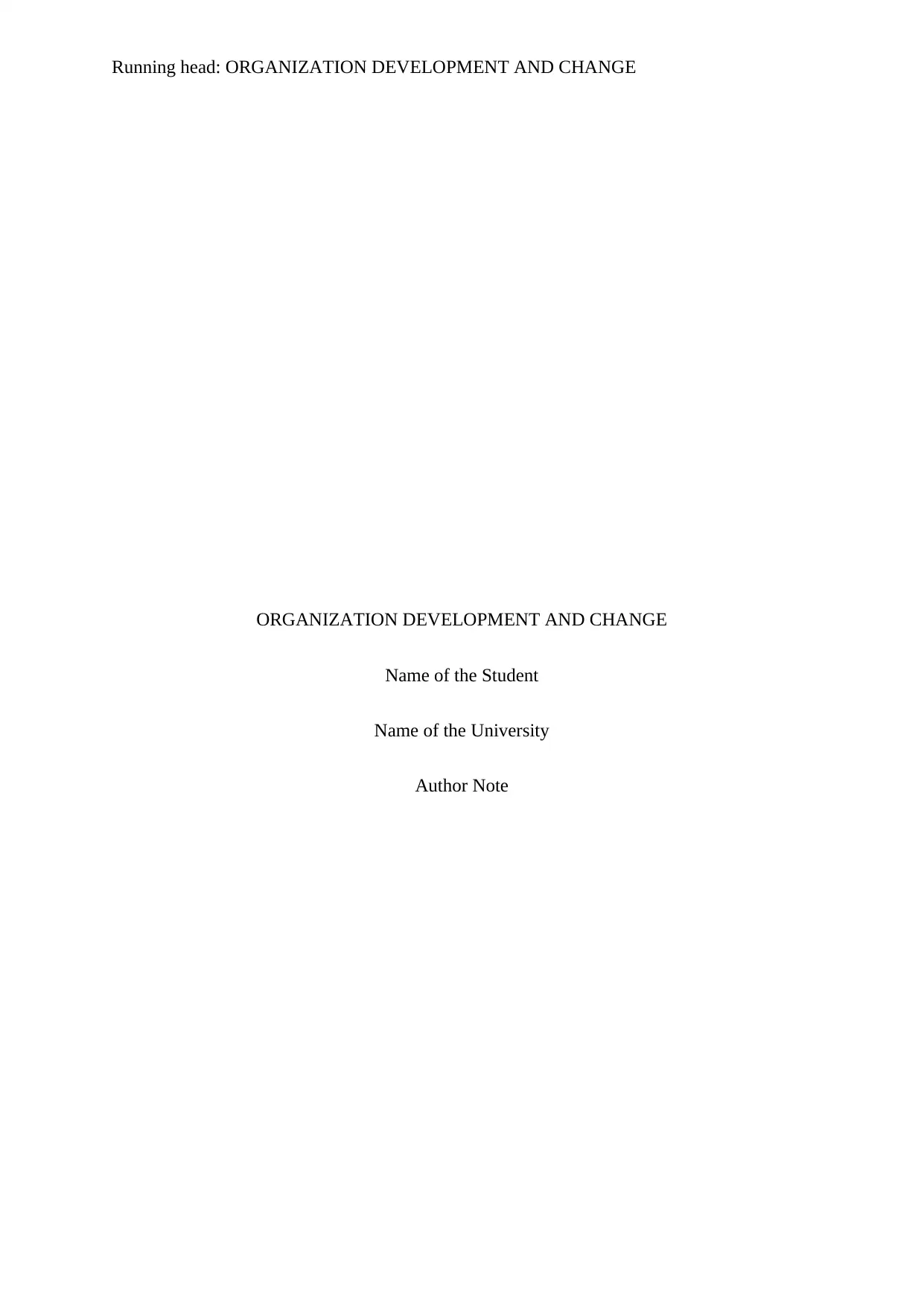
Running head: ORGANIZATION DEVELOPMENT AND CHANGE
ORGANIZATION DEVELOPMENT AND CHANGE
Name of the Student
Name of the University
Author Note
ORGANIZATION DEVELOPMENT AND CHANGE
Name of the Student
Name of the University
Author Note
Paraphrase This Document
Need a fresh take? Get an instant paraphrase of this document with our AI Paraphraser
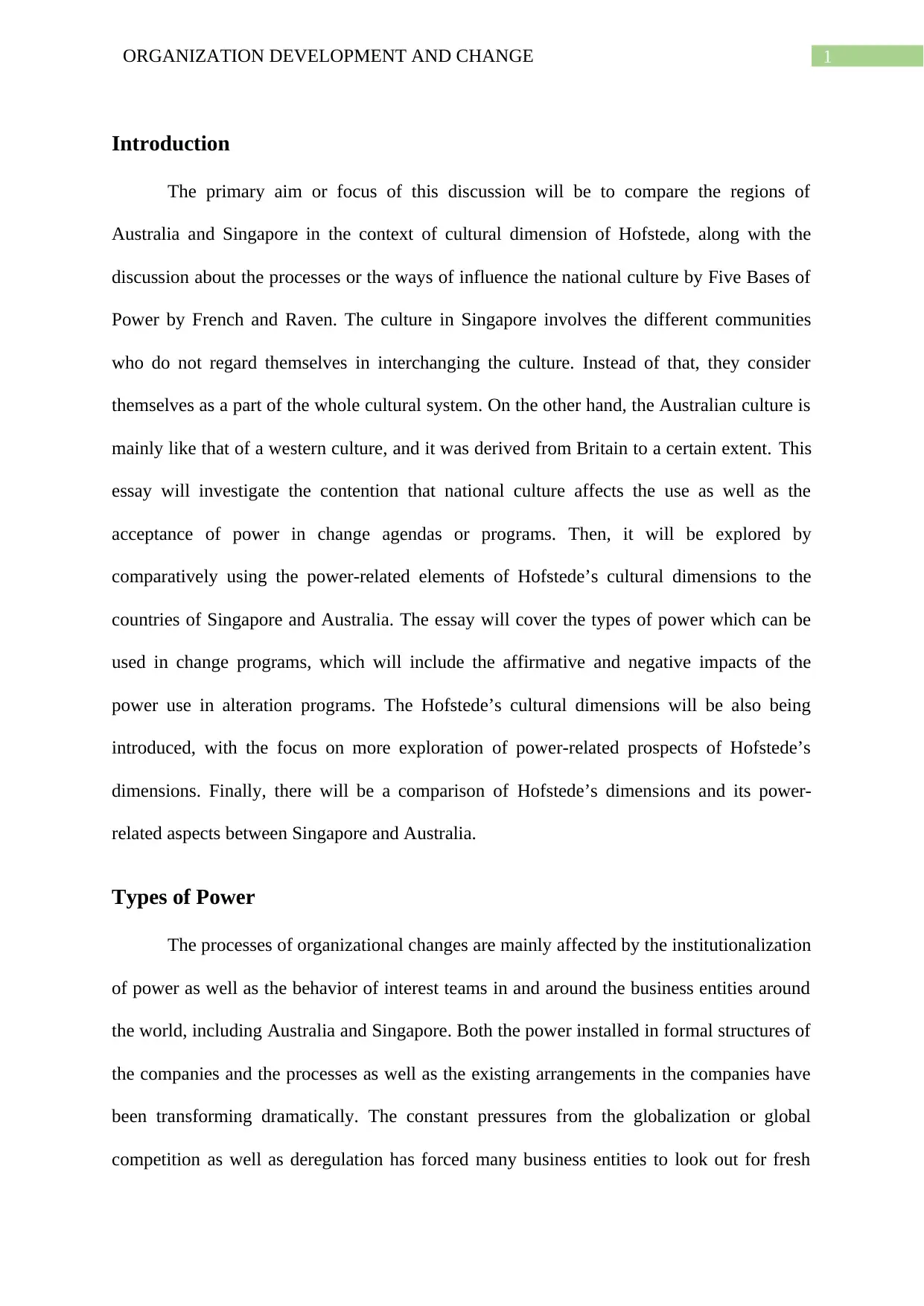
1ORGANIZATION DEVELOPMENT AND CHANGE
Introduction
The primary aim or focus of this discussion will be to compare the regions of
Australia and Singapore in the context of cultural dimension of Hofstede, along with the
discussion about the processes or the ways of influence the national culture by Five Bases of
Power by French and Raven. The culture in Singapore involves the different communities
who do not regard themselves in interchanging the culture. Instead of that, they consider
themselves as a part of the whole cultural system. On the other hand, the Australian culture is
mainly like that of a western culture, and it was derived from Britain to a certain extent. This
essay will investigate the contention that national culture affects the use as well as the
acceptance of power in change agendas or programs. Then, it will be explored by
comparatively using the power-related elements of Hofstede’s cultural dimensions to the
countries of Singapore and Australia. The essay will cover the types of power which can be
used in change programs, which will include the affirmative and negative impacts of the
power use in alteration programs. The Hofstede’s cultural dimensions will be also being
introduced, with the focus on more exploration of power-related prospects of Hofstede’s
dimensions. Finally, there will be a comparison of Hofstede’s dimensions and its power-
related aspects between Singapore and Australia.
Types of Power
The processes of organizational changes are mainly affected by the institutionalization
of power as well as the behavior of interest teams in and around the business entities around
the world, including Australia and Singapore. Both the power installed in formal structures of
the companies and the processes as well as the existing arrangements in the companies have
been transforming dramatically. The constant pressures from the globalization or global
competition as well as deregulation has forced many business entities to look out for fresh
Introduction
The primary aim or focus of this discussion will be to compare the regions of
Australia and Singapore in the context of cultural dimension of Hofstede, along with the
discussion about the processes or the ways of influence the national culture by Five Bases of
Power by French and Raven. The culture in Singapore involves the different communities
who do not regard themselves in interchanging the culture. Instead of that, they consider
themselves as a part of the whole cultural system. On the other hand, the Australian culture is
mainly like that of a western culture, and it was derived from Britain to a certain extent. This
essay will investigate the contention that national culture affects the use as well as the
acceptance of power in change agendas or programs. Then, it will be explored by
comparatively using the power-related elements of Hofstede’s cultural dimensions to the
countries of Singapore and Australia. The essay will cover the types of power which can be
used in change programs, which will include the affirmative and negative impacts of the
power use in alteration programs. The Hofstede’s cultural dimensions will be also being
introduced, with the focus on more exploration of power-related prospects of Hofstede’s
dimensions. Finally, there will be a comparison of Hofstede’s dimensions and its power-
related aspects between Singapore and Australia.
Types of Power
The processes of organizational changes are mainly affected by the institutionalization
of power as well as the behavior of interest teams in and around the business entities around
the world, including Australia and Singapore. Both the power installed in formal structures of
the companies and the processes as well as the existing arrangements in the companies have
been transforming dramatically. The constant pressures from the globalization or global
competition as well as deregulation has forced many business entities to look out for fresh
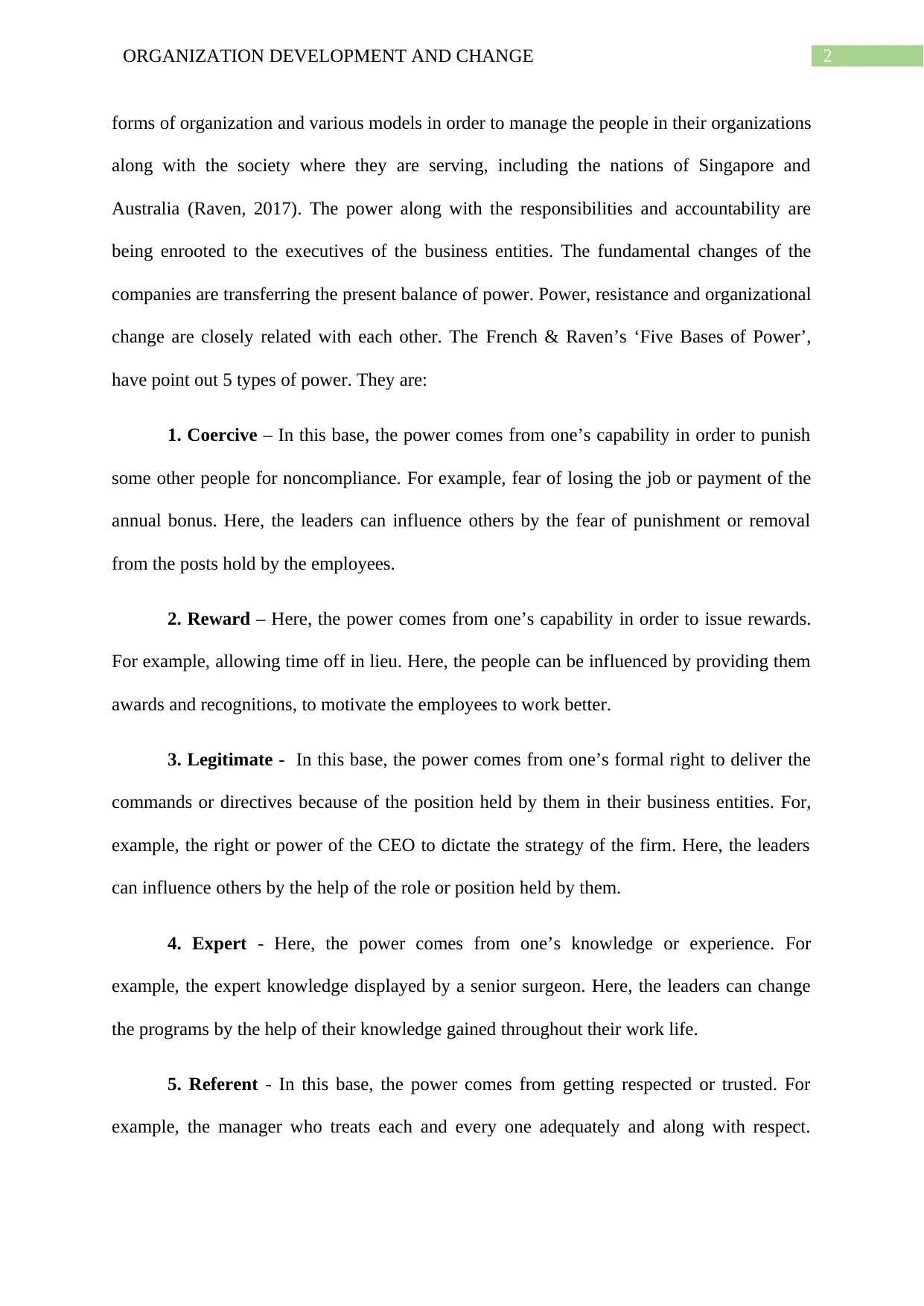
2ORGANIZATION DEVELOPMENT AND CHANGE
forms of organization and various models in order to manage the people in their organizations
along with the society where they are serving, including the nations of Singapore and
Australia (Raven, 2017). The power along with the responsibilities and accountability are
being enrooted to the executives of the business entities. The fundamental changes of the
companies are transferring the present balance of power. Power, resistance and organizational
change are closely related with each other. The French & Raven’s ‘Five Bases of Power’,
have point out 5 types of power. They are:
1. Coercive – In this base, the power comes from one’s capability in order to punish
some other people for noncompliance. For example, fear of losing the job or payment of the
annual bonus. Here, the leaders can influence others by the fear of punishment or removal
from the posts hold by the employees.
2. Reward – Here, the power comes from one’s capability in order to issue rewards.
For example, allowing time off in lieu. Here, the people can be influenced by providing them
awards and recognitions, to motivate the employees to work better.
3. Legitimate - In this base, the power comes from one’s formal right to deliver the
commands or directives because of the position held by them in their business entities. For,
example, the right or power of the CEO to dictate the strategy of the firm. Here, the leaders
can influence others by the help of the role or position held by them.
4. Expert - Here, the power comes from one’s knowledge or experience. For
example, the expert knowledge displayed by a senior surgeon. Here, the leaders can change
the programs by the help of their knowledge gained throughout their work life.
5. Referent - In this base, the power comes from getting respected or trusted. For
example, the manager who treats each and every one adequately and along with respect.
forms of organization and various models in order to manage the people in their organizations
along with the society where they are serving, including the nations of Singapore and
Australia (Raven, 2017). The power along with the responsibilities and accountability are
being enrooted to the executives of the business entities. The fundamental changes of the
companies are transferring the present balance of power. Power, resistance and organizational
change are closely related with each other. The French & Raven’s ‘Five Bases of Power’,
have point out 5 types of power. They are:
1. Coercive – In this base, the power comes from one’s capability in order to punish
some other people for noncompliance. For example, fear of losing the job or payment of the
annual bonus. Here, the leaders can influence others by the fear of punishment or removal
from the posts hold by the employees.
2. Reward – Here, the power comes from one’s capability in order to issue rewards.
For example, allowing time off in lieu. Here, the people can be influenced by providing them
awards and recognitions, to motivate the employees to work better.
3. Legitimate - In this base, the power comes from one’s formal right to deliver the
commands or directives because of the position held by them in their business entities. For,
example, the right or power of the CEO to dictate the strategy of the firm. Here, the leaders
can influence others by the help of the role or position held by them.
4. Expert - Here, the power comes from one’s knowledge or experience. For
example, the expert knowledge displayed by a senior surgeon. Here, the leaders can change
the programs by the help of their knowledge gained throughout their work life.
5. Referent - In this base, the power comes from getting respected or trusted. For
example, the manager who treats each and every one adequately and along with respect.
⊘ This is a preview!⊘
Do you want full access?
Subscribe today to unlock all pages.

Trusted by 1+ million students worldwide
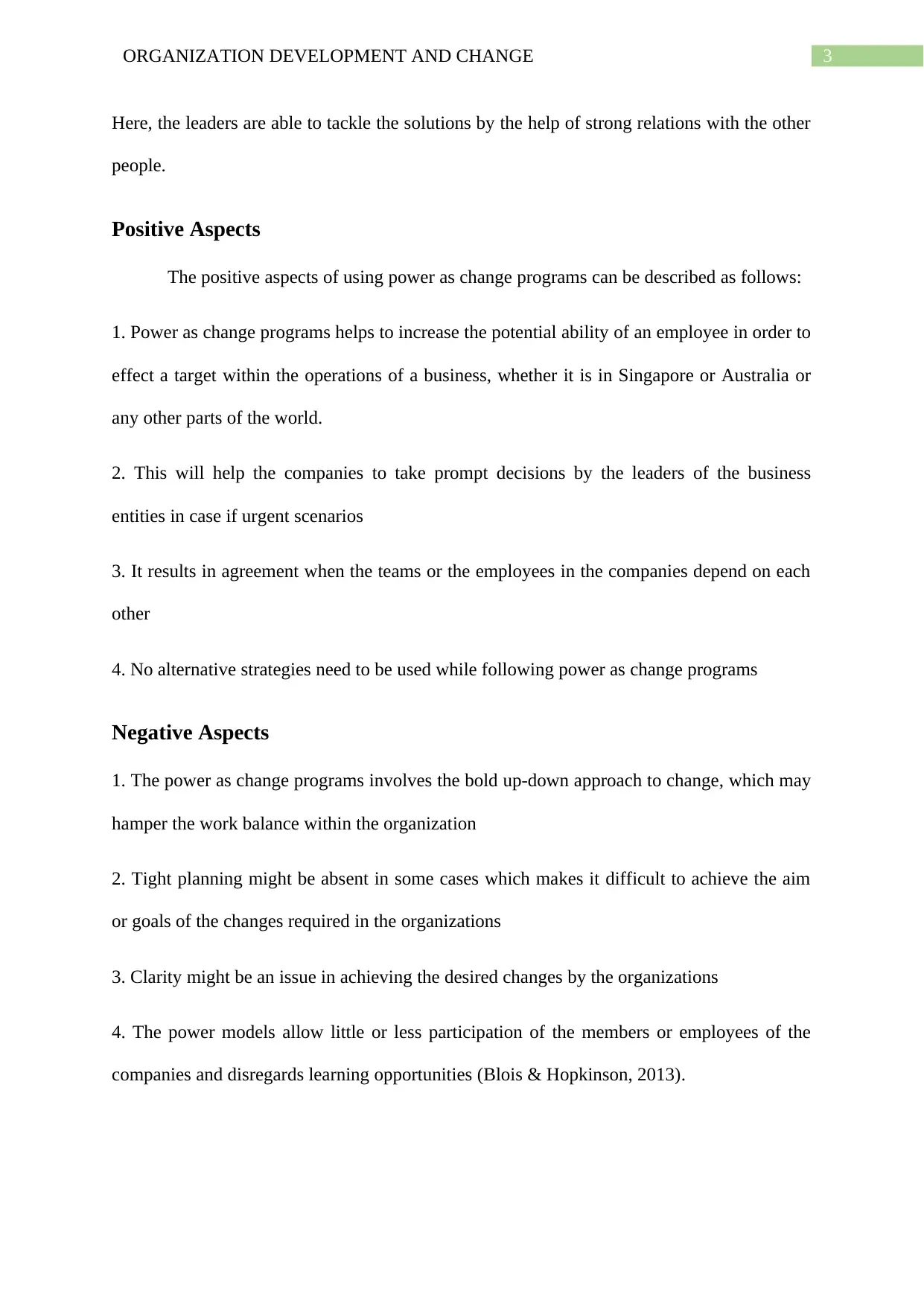
3ORGANIZATION DEVELOPMENT AND CHANGE
Here, the leaders are able to tackle the solutions by the help of strong relations with the other
people.
Positive Aspects
The positive aspects of using power as change programs can be described as follows:
1. Power as change programs helps to increase the potential ability of an employee in order to
effect a target within the operations of a business, whether it is in Singapore or Australia or
any other parts of the world.
2. This will help the companies to take prompt decisions by the leaders of the business
entities in case if urgent scenarios
3. It results in agreement when the teams or the employees in the companies depend on each
other
4. No alternative strategies need to be used while following power as change programs
Negative Aspects
1. The power as change programs involves the bold up-down approach to change, which may
hamper the work balance within the organization
2. Tight planning might be absent in some cases which makes it difficult to achieve the aim
or goals of the changes required in the organizations
3. Clarity might be an issue in achieving the desired changes by the organizations
4. The power models allow little or less participation of the members or employees of the
companies and disregards learning opportunities (Blois & Hopkinson, 2013).
Here, the leaders are able to tackle the solutions by the help of strong relations with the other
people.
Positive Aspects
The positive aspects of using power as change programs can be described as follows:
1. Power as change programs helps to increase the potential ability of an employee in order to
effect a target within the operations of a business, whether it is in Singapore or Australia or
any other parts of the world.
2. This will help the companies to take prompt decisions by the leaders of the business
entities in case if urgent scenarios
3. It results in agreement when the teams or the employees in the companies depend on each
other
4. No alternative strategies need to be used while following power as change programs
Negative Aspects
1. The power as change programs involves the bold up-down approach to change, which may
hamper the work balance within the organization
2. Tight planning might be absent in some cases which makes it difficult to achieve the aim
or goals of the changes required in the organizations
3. Clarity might be an issue in achieving the desired changes by the organizations
4. The power models allow little or less participation of the members or employees of the
companies and disregards learning opportunities (Blois & Hopkinson, 2013).
Paraphrase This Document
Need a fresh take? Get an instant paraphrase of this document with our AI Paraphraser
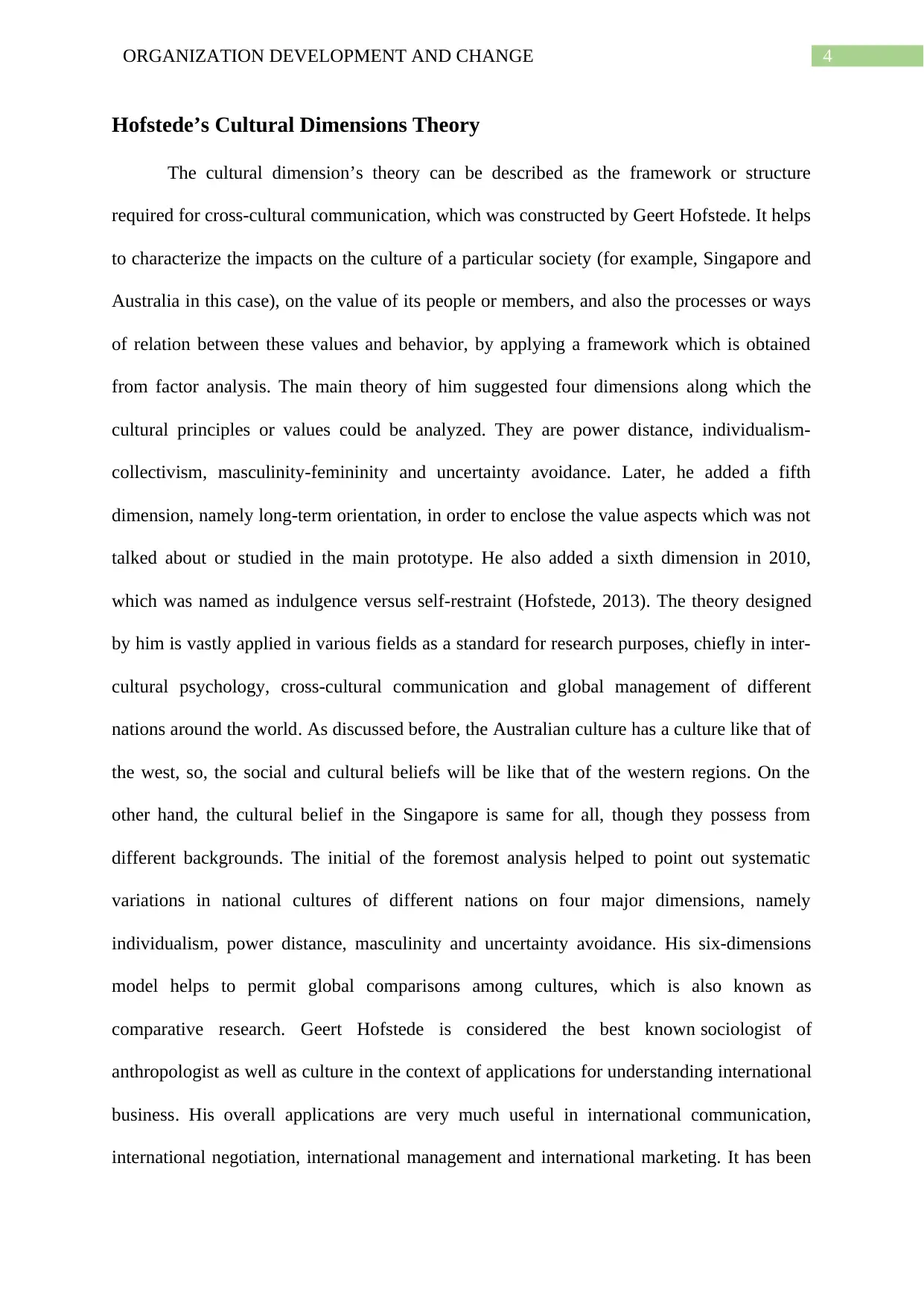
4ORGANIZATION DEVELOPMENT AND CHANGE
Hofstede’s Cultural Dimensions Theory
The cultural dimension’s theory can be described as the framework or structure
required for cross-cultural communication, which was constructed by Geert Hofstede. It helps
to characterize the impacts on the culture of a particular society (for example, Singapore and
Australia in this case), on the value of its people or members, and also the processes or ways
of relation between these values and behavior, by applying a framework which is obtained
from factor analysis. The main theory of him suggested four dimensions along which the
cultural principles or values could be analyzed. They are power distance, individualism-
collectivism, masculinity-femininity and uncertainty avoidance. Later, he added a fifth
dimension, namely long-term orientation, in order to enclose the value aspects which was not
talked about or studied in the main prototype. He also added a sixth dimension in 2010,
which was named as indulgence versus self-restraint (Hofstede, 2013). The theory designed
by him is vastly applied in various fields as a standard for research purposes, chiefly in inter-
cultural psychology, cross-cultural communication and global management of different
nations around the world. As discussed before, the Australian culture has a culture like that of
the west, so, the social and cultural beliefs will be like that of the western regions. On the
other hand, the cultural belief in the Singapore is same for all, though they possess from
different backgrounds. The initial of the foremost analysis helped to point out systematic
variations in national cultures of different nations on four major dimensions, namely
individualism, power distance, masculinity and uncertainty avoidance. His six-dimensions
model helps to permit global comparisons among cultures, which is also known as
comparative research. Geert Hofstede is considered the best known sociologist of
anthropologist as well as culture in the context of applications for understanding international
business. His overall applications are very much useful in international communication,
international negotiation, international management and international marketing. It has been
Hofstede’s Cultural Dimensions Theory
The cultural dimension’s theory can be described as the framework or structure
required for cross-cultural communication, which was constructed by Geert Hofstede. It helps
to characterize the impacts on the culture of a particular society (for example, Singapore and
Australia in this case), on the value of its people or members, and also the processes or ways
of relation between these values and behavior, by applying a framework which is obtained
from factor analysis. The main theory of him suggested four dimensions along which the
cultural principles or values could be analyzed. They are power distance, individualism-
collectivism, masculinity-femininity and uncertainty avoidance. Later, he added a fifth
dimension, namely long-term orientation, in order to enclose the value aspects which was not
talked about or studied in the main prototype. He also added a sixth dimension in 2010,
which was named as indulgence versus self-restraint (Hofstede, 2013). The theory designed
by him is vastly applied in various fields as a standard for research purposes, chiefly in inter-
cultural psychology, cross-cultural communication and global management of different
nations around the world. As discussed before, the Australian culture has a culture like that of
the west, so, the social and cultural beliefs will be like that of the western regions. On the
other hand, the cultural belief in the Singapore is same for all, though they possess from
different backgrounds. The initial of the foremost analysis helped to point out systematic
variations in national cultures of different nations on four major dimensions, namely
individualism, power distance, masculinity and uncertainty avoidance. His six-dimensions
model helps to permit global comparisons among cultures, which is also known as
comparative research. Geert Hofstede is considered the best known sociologist of
anthropologist as well as culture in the context of applications for understanding international
business. His overall applications are very much useful in international communication,
international negotiation, international management and international marketing. It has been
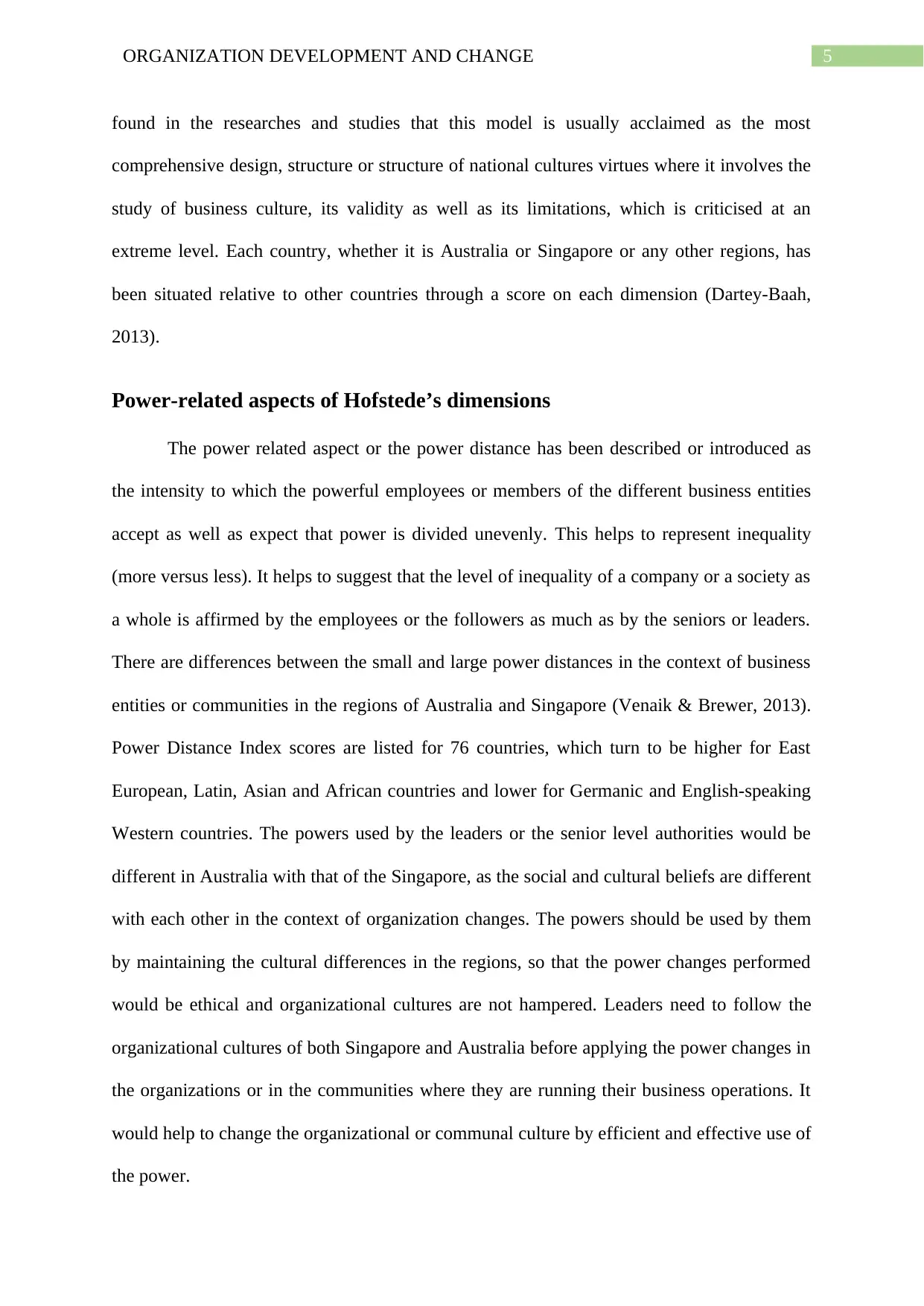
5ORGANIZATION DEVELOPMENT AND CHANGE
found in the researches and studies that this model is usually acclaimed as the most
comprehensive design, structure or structure of national cultures virtues where it involves the
study of business culture, its validity as well as its limitations, which is criticised at an
extreme level. Each country, whether it is Australia or Singapore or any other regions, has
been situated relative to other countries through a score on each dimension (Dartey-Baah,
2013).
Power-related aspects of Hofstede’s dimensions
The power related aspect or the power distance has been described or introduced as
the intensity to which the powerful employees or members of the different business entities
accept as well as expect that power is divided unevenly. This helps to represent inequality
(more versus less). It helps to suggest that the level of inequality of a company or a society as
a whole is affirmed by the employees or the followers as much as by the seniors or leaders.
There are differences between the small and large power distances in the context of business
entities or communities in the regions of Australia and Singapore (Venaik & Brewer, 2013).
Power Distance Index scores are listed for 76 countries, which turn to be higher for East
European, Latin, Asian and African countries and lower for Germanic and English-speaking
Western countries. The powers used by the leaders or the senior level authorities would be
different in Australia with that of the Singapore, as the social and cultural beliefs are different
with each other in the context of organization changes. The powers should be used by them
by maintaining the cultural differences in the regions, so that the power changes performed
would be ethical and organizational cultures are not hampered. Leaders need to follow the
organizational cultures of both Singapore and Australia before applying the power changes in
the organizations or in the communities where they are running their business operations. It
would help to change the organizational or communal culture by efficient and effective use of
the power.
found in the researches and studies that this model is usually acclaimed as the most
comprehensive design, structure or structure of national cultures virtues where it involves the
study of business culture, its validity as well as its limitations, which is criticised at an
extreme level. Each country, whether it is Australia or Singapore or any other regions, has
been situated relative to other countries through a score on each dimension (Dartey-Baah,
2013).
Power-related aspects of Hofstede’s dimensions
The power related aspect or the power distance has been described or introduced as
the intensity to which the powerful employees or members of the different business entities
accept as well as expect that power is divided unevenly. This helps to represent inequality
(more versus less). It helps to suggest that the level of inequality of a company or a society as
a whole is affirmed by the employees or the followers as much as by the seniors or leaders.
There are differences between the small and large power distances in the context of business
entities or communities in the regions of Australia and Singapore (Venaik & Brewer, 2013).
Power Distance Index scores are listed for 76 countries, which turn to be higher for East
European, Latin, Asian and African countries and lower for Germanic and English-speaking
Western countries. The powers used by the leaders or the senior level authorities would be
different in Australia with that of the Singapore, as the social and cultural beliefs are different
with each other in the context of organization changes. The powers should be used by them
by maintaining the cultural differences in the regions, so that the power changes performed
would be ethical and organizational cultures are not hampered. Leaders need to follow the
organizational cultures of both Singapore and Australia before applying the power changes in
the organizations or in the communities where they are running their business operations. It
would help to change the organizational or communal culture by efficient and effective use of
the power.
⊘ This is a preview!⊘
Do you want full access?
Subscribe today to unlock all pages.

Trusted by 1+ million students worldwide
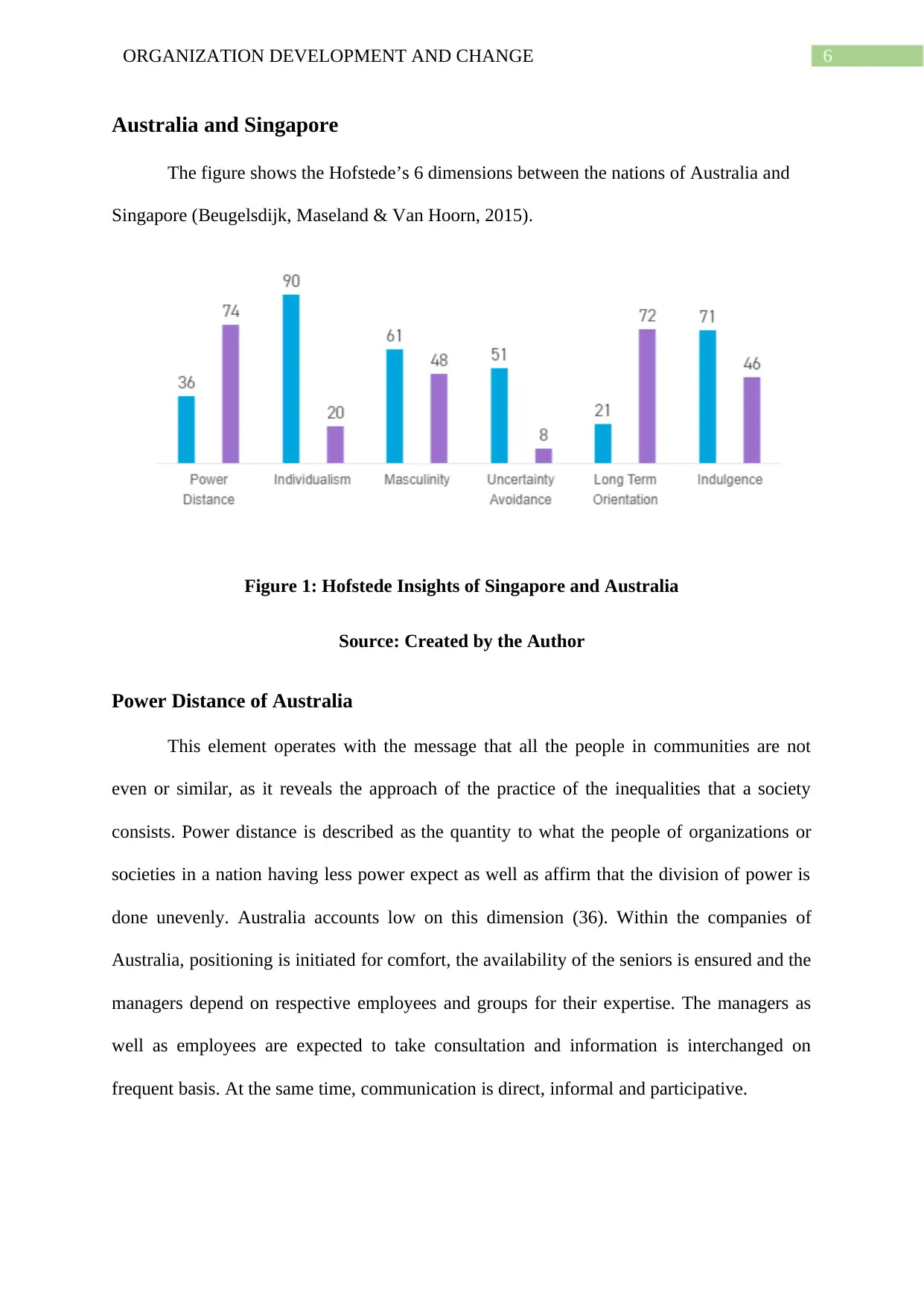
6ORGANIZATION DEVELOPMENT AND CHANGE
Australia and Singapore
The figure shows the Hofstede’s 6 dimensions between the nations of Australia and
Singapore (Beugelsdijk, Maseland & Van Hoorn, 2015).
Figure 1: Hofstede Insights of Singapore and Australia
Source: Created by the Author
Power Distance of Australia
This element operates with the message that all the people in communities are not
even or similar, as it reveals the approach of the practice of the inequalities that a society
consists. Power distance is described as the quantity to what the people of organizations or
societies in a nation having less power expect as well as affirm that the division of power is
done unevenly. Australia accounts low on this dimension (36). Within the companies of
Australia, positioning is initiated for comfort, the availability of the seniors is ensured and the
managers depend on respective employees and groups for their expertise. The managers as
well as employees are expected to take consultation and information is interchanged on
frequent basis. At the same time, communication is direct, informal and participative.
Australia and Singapore
The figure shows the Hofstede’s 6 dimensions between the nations of Australia and
Singapore (Beugelsdijk, Maseland & Van Hoorn, 2015).
Figure 1: Hofstede Insights of Singapore and Australia
Source: Created by the Author
Power Distance of Australia
This element operates with the message that all the people in communities are not
even or similar, as it reveals the approach of the practice of the inequalities that a society
consists. Power distance is described as the quantity to what the people of organizations or
societies in a nation having less power expect as well as affirm that the division of power is
done unevenly. Australia accounts low on this dimension (36). Within the companies of
Australia, positioning is initiated for comfort, the availability of the seniors is ensured and the
managers depend on respective employees and groups for their expertise. The managers as
well as employees are expected to take consultation and information is interchanged on
frequent basis. At the same time, communication is direct, informal and participative.
Paraphrase This Document
Need a fresh take? Get an instant paraphrase of this document with our AI Paraphraser
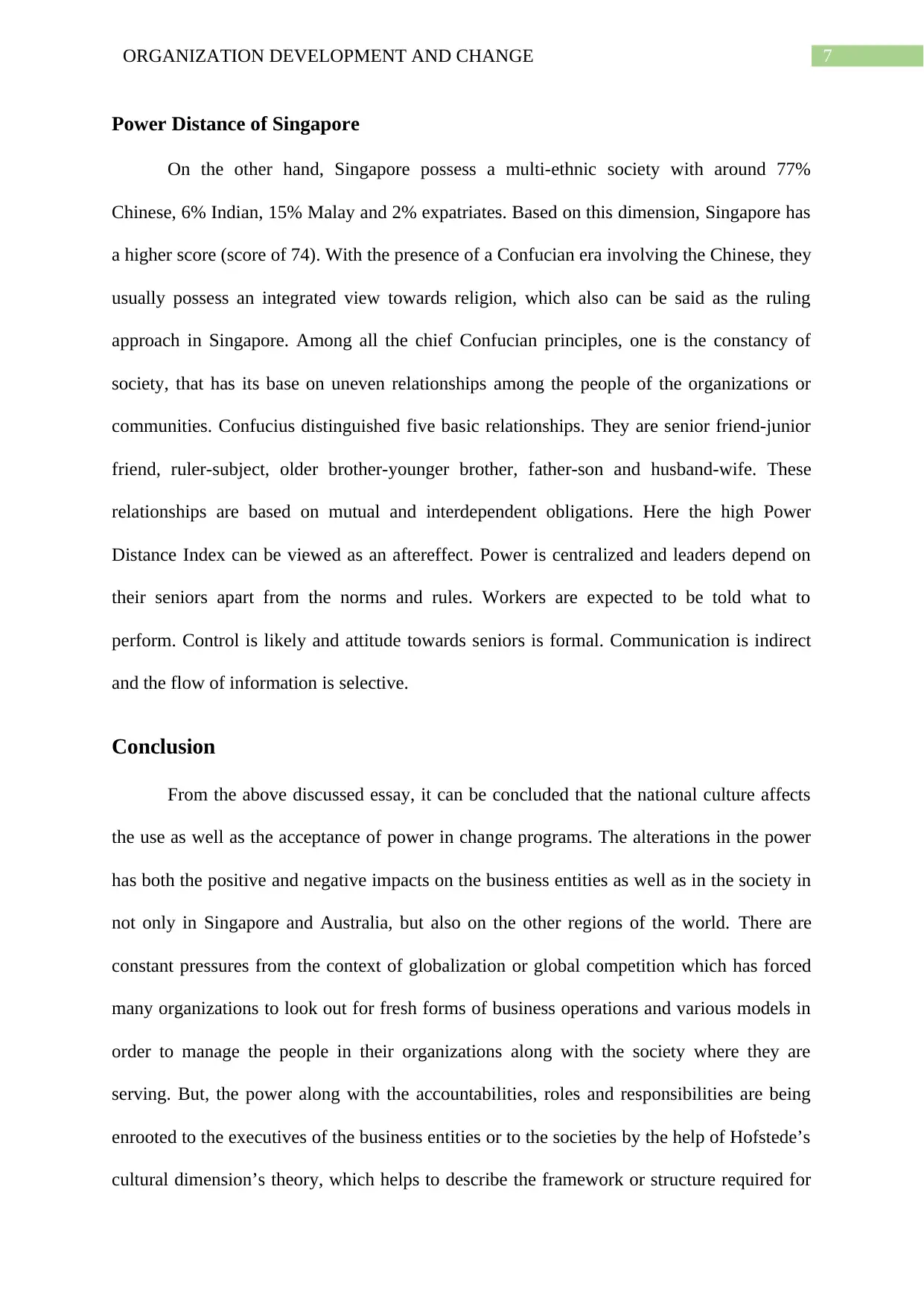
7ORGANIZATION DEVELOPMENT AND CHANGE
Power Distance of Singapore
On the other hand, Singapore possess a multi-ethnic society with around 77%
Chinese, 6% Indian, 15% Malay and 2% expatriates. Based on this dimension, Singapore has
a higher score (score of 74). With the presence of a Confucian era involving the Chinese, they
usually possess an integrated view towards religion, which also can be said as the ruling
approach in Singapore. Among all the chief Confucian principles, one is the constancy of
society, that has its base on uneven relationships among the people of the organizations or
communities. Confucius distinguished five basic relationships. They are senior friend-junior
friend, ruler-subject, older brother-younger brother, father-son and husband-wife. These
relationships are based on mutual and interdependent obligations. Here the high Power
Distance Index can be viewed as an aftereffect. Power is centralized and leaders depend on
their seniors apart from the norms and rules. Workers are expected to be told what to
perform. Control is likely and attitude towards seniors is formal. Communication is indirect
and the flow of information is selective.
Conclusion
From the above discussed essay, it can be concluded that the national culture affects
the use as well as the acceptance of power in change programs. The alterations in the power
has both the positive and negative impacts on the business entities as well as in the society in
not only in Singapore and Australia, but also on the other regions of the world. There are
constant pressures from the context of globalization or global competition which has forced
many organizations to look out for fresh forms of business operations and various models in
order to manage the people in their organizations along with the society where they are
serving. But, the power along with the accountabilities, roles and responsibilities are being
enrooted to the executives of the business entities or to the societies by the help of Hofstede’s
cultural dimension’s theory, which helps to describe the framework or structure required for
Power Distance of Singapore
On the other hand, Singapore possess a multi-ethnic society with around 77%
Chinese, 6% Indian, 15% Malay and 2% expatriates. Based on this dimension, Singapore has
a higher score (score of 74). With the presence of a Confucian era involving the Chinese, they
usually possess an integrated view towards religion, which also can be said as the ruling
approach in Singapore. Among all the chief Confucian principles, one is the constancy of
society, that has its base on uneven relationships among the people of the organizations or
communities. Confucius distinguished five basic relationships. They are senior friend-junior
friend, ruler-subject, older brother-younger brother, father-son and husband-wife. These
relationships are based on mutual and interdependent obligations. Here the high Power
Distance Index can be viewed as an aftereffect. Power is centralized and leaders depend on
their seniors apart from the norms and rules. Workers are expected to be told what to
perform. Control is likely and attitude towards seniors is formal. Communication is indirect
and the flow of information is selective.
Conclusion
From the above discussed essay, it can be concluded that the national culture affects
the use as well as the acceptance of power in change programs. The alterations in the power
has both the positive and negative impacts on the business entities as well as in the society in
not only in Singapore and Australia, but also on the other regions of the world. There are
constant pressures from the context of globalization or global competition which has forced
many organizations to look out for fresh forms of business operations and various models in
order to manage the people in their organizations along with the society where they are
serving. But, the power along with the accountabilities, roles and responsibilities are being
enrooted to the executives of the business entities or to the societies by the help of Hofstede’s
cultural dimension’s theory, which helps to describe the framework or structure required for
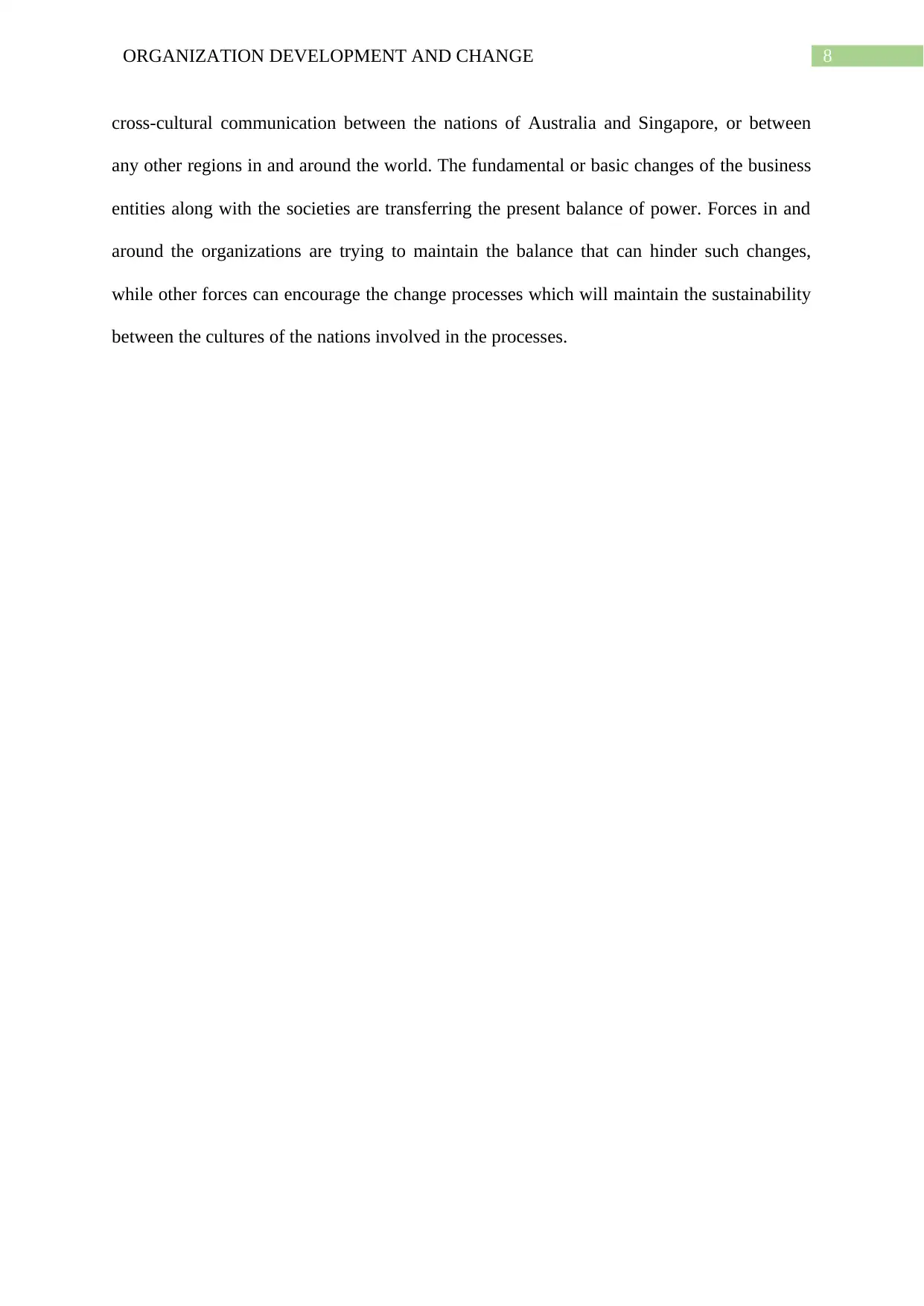
8ORGANIZATION DEVELOPMENT AND CHANGE
cross-cultural communication between the nations of Australia and Singapore, or between
any other regions in and around the world. The fundamental or basic changes of the business
entities along with the societies are transferring the present balance of power. Forces in and
around the organizations are trying to maintain the balance that can hinder such changes,
while other forces can encourage the change processes which will maintain the sustainability
between the cultures of the nations involved in the processes.
cross-cultural communication between the nations of Australia and Singapore, or between
any other regions in and around the world. The fundamental or basic changes of the business
entities along with the societies are transferring the present balance of power. Forces in and
around the organizations are trying to maintain the balance that can hinder such changes,
while other forces can encourage the change processes which will maintain the sustainability
between the cultures of the nations involved in the processes.
⊘ This is a preview!⊘
Do you want full access?
Subscribe today to unlock all pages.

Trusted by 1+ million students worldwide
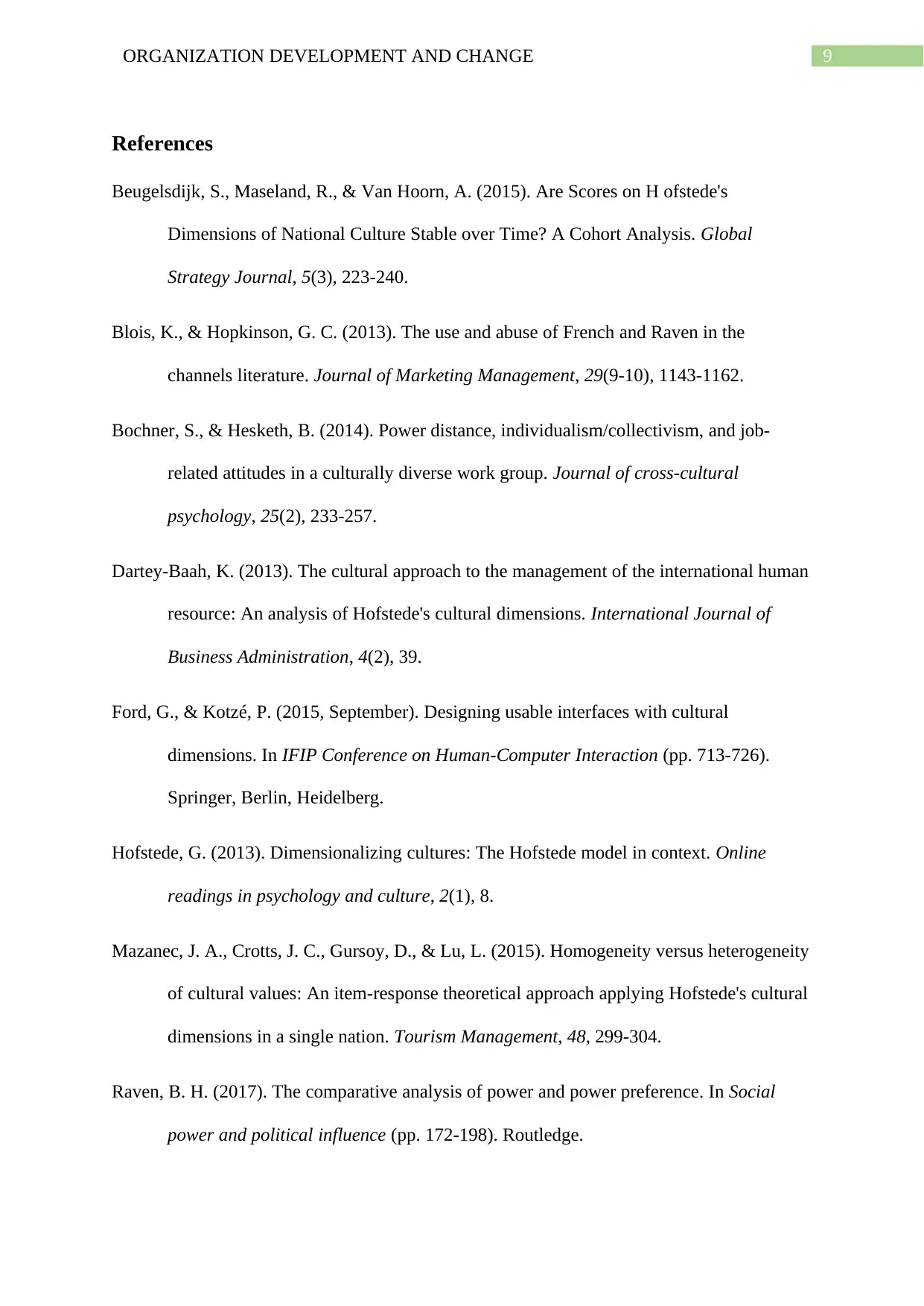
9ORGANIZATION DEVELOPMENT AND CHANGE
References
Beugelsdijk, S., Maseland, R., & Van Hoorn, A. (2015). Are Scores on H ofstede's
Dimensions of National Culture Stable over Time? A Cohort Analysis. Global
Strategy Journal, 5(3), 223-240.
Blois, K., & Hopkinson, G. C. (2013). The use and abuse of French and Raven in the
channels literature. Journal of Marketing Management, 29(9-10), 1143-1162.
Bochner, S., & Hesketh, B. (2014). Power distance, individualism/collectivism, and job-
related attitudes in a culturally diverse work group. Journal of cross-cultural
psychology, 25(2), 233-257.
Dartey-Baah, K. (2013). The cultural approach to the management of the international human
resource: An analysis of Hofstede's cultural dimensions. International Journal of
Business Administration, 4(2), 39.
Ford, G., & Kotzé, P. (2015, September). Designing usable interfaces with cultural
dimensions. In IFIP Conference on Human-Computer Interaction (pp. 713-726).
Springer, Berlin, Heidelberg.
Hofstede, G. (2013). Dimensionalizing cultures: The Hofstede model in context. Online
readings in psychology and culture, 2(1), 8.
Mazanec, J. A., Crotts, J. C., Gursoy, D., & Lu, L. (2015). Homogeneity versus heterogeneity
of cultural values: An item-response theoretical approach applying Hofstede's cultural
dimensions in a single nation. Tourism Management, 48, 299-304.
Raven, B. H. (2017). The comparative analysis of power and power preference. In Social
power and political influence (pp. 172-198). Routledge.
References
Beugelsdijk, S., Maseland, R., & Van Hoorn, A. (2015). Are Scores on H ofstede's
Dimensions of National Culture Stable over Time? A Cohort Analysis. Global
Strategy Journal, 5(3), 223-240.
Blois, K., & Hopkinson, G. C. (2013). The use and abuse of French and Raven in the
channels literature. Journal of Marketing Management, 29(9-10), 1143-1162.
Bochner, S., & Hesketh, B. (2014). Power distance, individualism/collectivism, and job-
related attitudes in a culturally diverse work group. Journal of cross-cultural
psychology, 25(2), 233-257.
Dartey-Baah, K. (2013). The cultural approach to the management of the international human
resource: An analysis of Hofstede's cultural dimensions. International Journal of
Business Administration, 4(2), 39.
Ford, G., & Kotzé, P. (2015, September). Designing usable interfaces with cultural
dimensions. In IFIP Conference on Human-Computer Interaction (pp. 713-726).
Springer, Berlin, Heidelberg.
Hofstede, G. (2013). Dimensionalizing cultures: The Hofstede model in context. Online
readings in psychology and culture, 2(1), 8.
Mazanec, J. A., Crotts, J. C., Gursoy, D., & Lu, L. (2015). Homogeneity versus heterogeneity
of cultural values: An item-response theoretical approach applying Hofstede's cultural
dimensions in a single nation. Tourism Management, 48, 299-304.
Raven, B. H. (2017). The comparative analysis of power and power preference. In Social
power and political influence (pp. 172-198). Routledge.
Paraphrase This Document
Need a fresh take? Get an instant paraphrase of this document with our AI Paraphraser
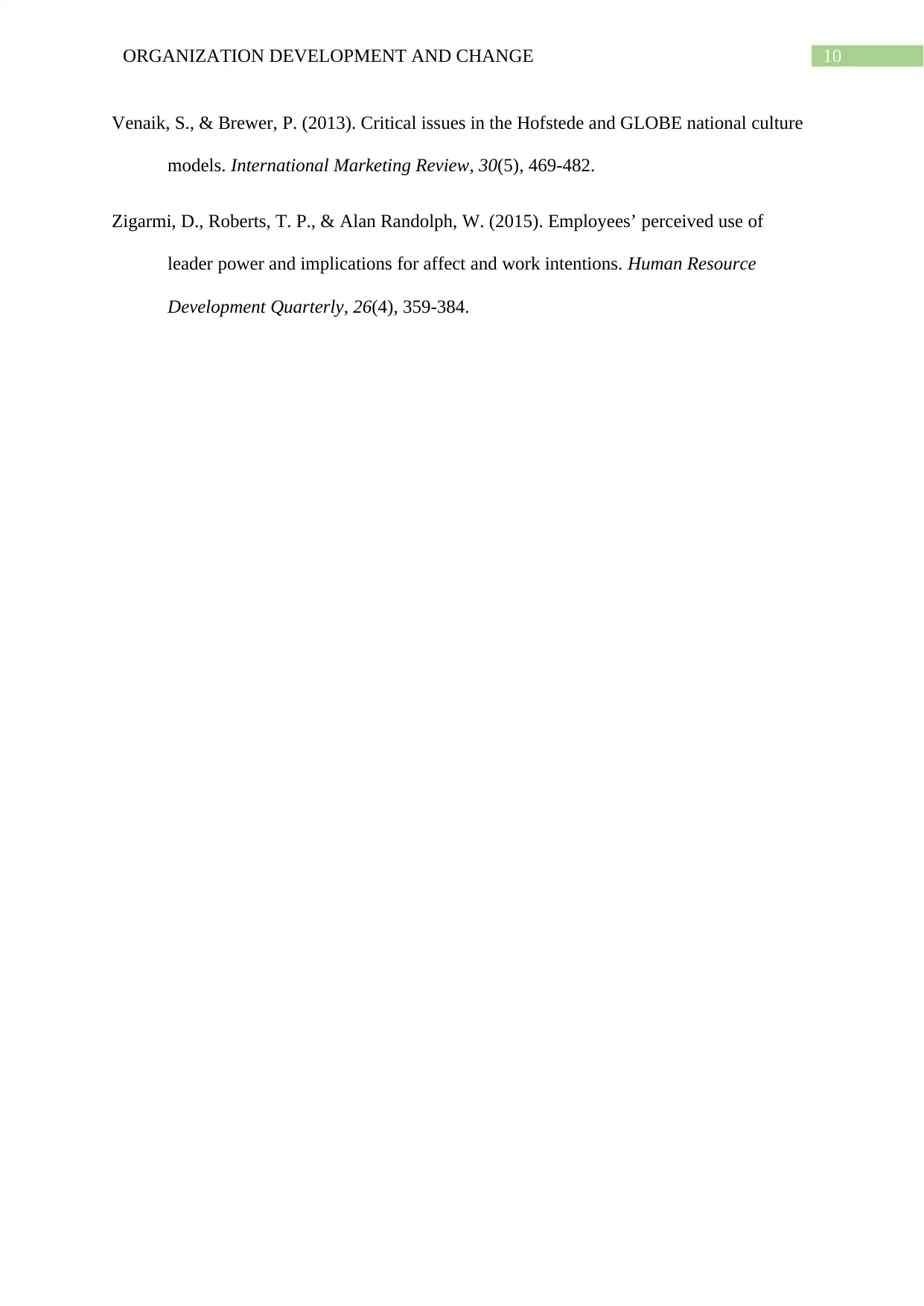
10ORGANIZATION DEVELOPMENT AND CHANGE
Venaik, S., & Brewer, P. (2013). Critical issues in the Hofstede and GLOBE national culture
models. International Marketing Review, 30(5), 469-482.
Zigarmi, D., Roberts, T. P., & Alan Randolph, W. (2015). Employees’ perceived use of
leader power and implications for affect and work intentions. Human Resource
Development Quarterly, 26(4), 359-384.
Venaik, S., & Brewer, P. (2013). Critical issues in the Hofstede and GLOBE national culture
models. International Marketing Review, 30(5), 469-482.
Zigarmi, D., Roberts, T. P., & Alan Randolph, W. (2015). Employees’ perceived use of
leader power and implications for affect and work intentions. Human Resource
Development Quarterly, 26(4), 359-384.
1 out of 11
Related Documents
Your All-in-One AI-Powered Toolkit for Academic Success.
+13062052269
info@desklib.com
Available 24*7 on WhatsApp / Email
![[object Object]](/_next/static/media/star-bottom.7253800d.svg)
Unlock your academic potential
Copyright © 2020–2025 A2Z Services. All Rights Reserved. Developed and managed by ZUCOL.





